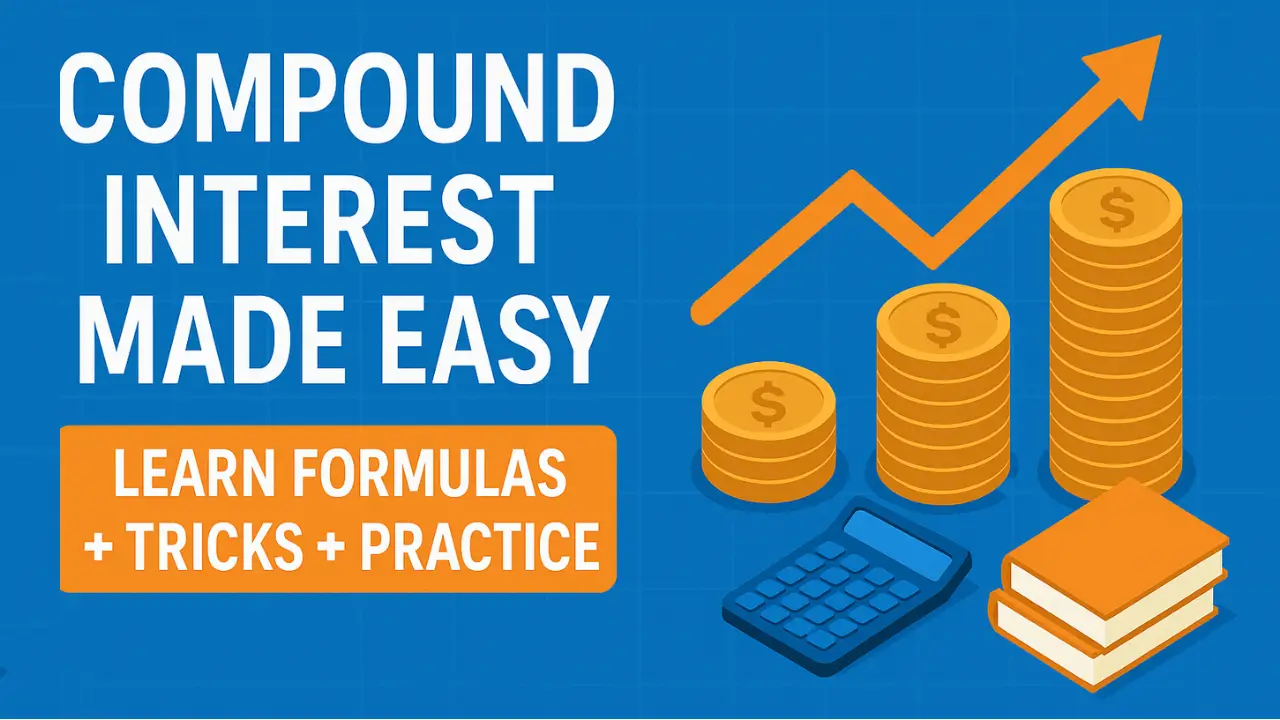💡 What is Compound Interest?
Compound Interest (CI) is the interest calculated on the principal and the accumulated interest of previous periods. This means your money grows faster with compound interest compared to simple interest.
In simple words, compound interest = Simple Interest + Interest on Interest.
🧮 Compound Interest Basic Formula:
To understand the compound interest basic concept, first learn the core formula:
Amount (A) = P × (1 + R/100)ⁿ
Where,
- P = Principal (initial amount)
- R = Rate of interest per annum
- n = Number of years
- A = Final amount (after interest)
Then, Compound Interest (CI) = A – P
🔢 Example to Understand the Compound Interest Basic Concept:
Let’s say you invest ₹10,000 at 10% per annum compound interest for 2 years.
Step 1:
A = 10000 × (1 + 10/100)²
= 10000 × (1.1)²
= 10000 × 1.21
= ₹12,100
Step 2:
CI = A – P = 12100 – 10000 = ₹2100
So, the compound interest earned is ₹2100.
📈 Compound Interest vs Simple Interest:
| Basis | Simple Interest | Compound Interest |
|---|---|---|
| Interest On | Principal only | Principal + Previous Interest |
| Growth Rate | Slower | Faster |
| Formula | (P × R × T)/100 | P × (1 + R/100)ⁿ – P |
| Used In | Short-term loans | Investments, bank savings |
Understanding this difference is key to mastering the compound interest basic concept.
🧾 Year-wise Table of Compound Interest:
Here is how ₹10,000 grows at 10% annual compound interest:
| Year | Amount (₹) | Interest (₹) |
|---|---|---|
| 1 | 11,000 | 1,000 |
| 2 | 12,100 | 1,100 |
| 3 | 13,310 | 1,210 |
| 4 | 14,641 | 1,331 |
| 5 | 16,105 | 1,464 |
As you can see, the interest increases every year. This is the power of compounding.
🔁 Compounded More Than Once a Year:
When the interest is compounded half-yearly or quarterly, the formula changes slightly:
Half-Yearly Compounding:
A = P × (1 + R/200)^(2n)
Quarterly Compounding:
A = P × (1 + R/400)^(4n)
Let’s see an example.
Example:
₹8000 invested at 10% per annum, compounded half-yearly for 1 year.
A = 8000 × (1 + 10/200)²
= 8000 × (1.05)² = 8000 × 1.1025 = ₹8820
CI = 8820 – 8000 = ₹820
🧠 Tricks to Remember:
- If the rate and time are the same, CI is always higher than SI.
- If the interest is compounded yearly, use the standard formula.
- For half-yearly and quarterly, divide the rate and multiply time accordingly.
- For small rates and small time, CI ≈ SI.
📝 Practice Questions with Answers:
Q1. Find compound interest on ₹5000 at 8% p.a. for 2 years.
Solution:
A = 5000 × (1 + 8/100)² = 5000 × (1.08)² = 5000 × 1.1664 = ₹5832
CI = 5832 – 5000 = ₹832
Q2. ₹6000 at 10% per annum compounded half-yearly for 1 year?
Solution:
A = 6000 × (1 + 10/200)² = 6000 × (1.05)² = 6000 × 1.1025 = ₹6615
CI = ₹6615 – ₹6000 = ₹615
Q3. Find the amount and compound interest on ₹2000 for 3 years at 5% p.a.
Solution:
A = 2000 × (1 + 5/100)³ = 2000 × (1.157625) = ₹2315.25
CI = ₹2315.25 – ₹2000 = ₹315.25
📊 Interest Growth Chart:
| Time (Years) | CI at 5% on ₹1000 |
|---|---|
| 1 | ₹50 |
| 2 | ₹102.5 |
| 3 | ₹157.63 |
| 4 | ₹215.51 |
This table helps visualize how interest grows faster over time, which is the essence of the compound interest basic concept.
💼 Real-Life Applications of Compound Interest:
- Bank Savings Accounts
- Fixed Deposits
- Loans and Mortgages
- Investment Returns
- Retirement Planning
If you understand the compound interest basic concept, you can make smarter money decisions.
🧩 FAQs on Compound Interest:
Q: Is compound interest better than simple interest?
Yes, it gives better returns due to interest on interest.
Q: In which exams is compound interest important?
Banking exams (IBPS, SBI), SSC, Railways, UPSC, State PSCs, and academic exams.
Q: How do I solve compound interest fast in exams?
Use short tricks, memorize powers like (1.1)² = 1.21, (1.05)³ = 1.157, and practice regularly.
✅ Conclusion:
The compound interest basic concept is simple once you understand the logic and formula behind it. It plays a major role not just in exams but also in daily life and financial planning. Always remember that compound interest is more powerful than simple interest because it helps your money grow faster.
Practice regularly using the formulas, examples, and practice questions provided here to boost your preparation for any competitive exam. Understanding this topic well will save you time and score marks easily.
You Might Also Like:
- Must-Know Algebra Formulas for Competitive Exams with Examples & Questions
- Simple Interest Important Concepts
- Percentage Formula & Shortcut Tricks for Exams
🔗 Follow Us for More:
📘 Follow us on Facebook for daily maths practice, exam tips, and updates:
👉 Join Mathsmine on Facebook







